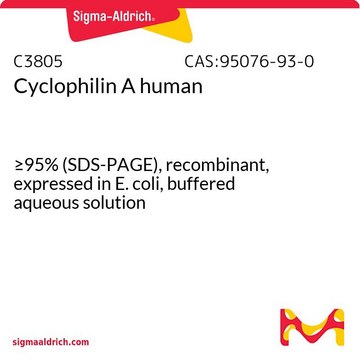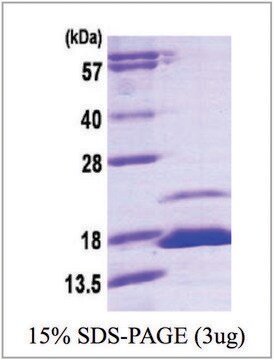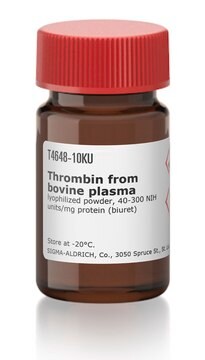SRP6091
FKBP1a/FKBP12 human
recombinant, expressed in E. coli, ≥95% (SDS-PAGE)
Synonim(y):
12 kDa FK506-binding protein, Calstabin-1, FK506 binding protein 1a, Immunophilin FKBP12, PPIase FKBP1A
Zaloguj sięWyświetlanie cen organizacyjnych i kontraktowych
About This Item
Polecane produkty
pochodzenie biologiczne
human
rekombinowane
expressed in E. coli
Próba
≥95% (SDS-PAGE)
Postać
liquid
masa cząsteczkowa
14.1 kDa
opakowanie
pkg of 100 μg
numer dostępu NCBI
numer dostępu UniProt
Warunki transportu
dry ice
temp. przechowywania
−70°C
informacje o genach
human ... FKBP1A(2280)
Opis ogólny
FKBP1A is part of the family of immunophilins, which have in common high affinity for immunosuppressant drugs and a peptidyl-prolyl cis-trans isomerase (PPIase). In the absence of immunosuppressive ligands, FKBP1A is involved in intracellular calcium regulation by associating with 3 types of Ca2+ release channel complexes: skeletal ryanodine receptors, cardiac ryanodine receptors and the inositol 1, 4, 5-triphosphate receptor. FKBP1A also interacts with TGF type I receptor exerting an inhibitory effect on the TGF?-I signaling pathway. FKBP12 plays a role in modulation of ryanodine receptor isoform-1 (ryr-1), a component of the calcium release channel of skeletal muscle sarcoplasmic reticulum. FKBP1A increase the folding of proteins and catalyzes the cis-trans isomerization of proline imidic peptide bonds in oligopeptides.
FKFBP1A (FK506-binding protein 1A) belongs to the FK506-binding protein (FKBP) family. It is widely expressed in nerve systems. This gene is mapped to human chromosome 20p13. FKFBP1A interacts with various cellular molecules and participates in intracellular signaling pathways.
Działania biochem./fizjol.
FKFBP1A (FK506-binding protein 1A) is a peptidyl-prolyl cis-trans isomerase. It interacts with the ryanodine receptor (RyR1) and helps in maintaining intracellular Ca2+ homeostasis. It is also involved in protein folding, cell cycle and protein trafficking. In neurodegenerative diseases, FKFBP1A is dysregulated and might be associated with the pathogenesis. In human cell lines, it controls the localization and processing of amyloid precursor protein, and thus might be involved in the pathogenesis of Alzheimer′s disease. FKFBP1A is also involved in Huntington′s disease. It plays a role in the structural properties and proteotoxicity of mHTT (mutant huntingtin) aggregates.
Postać fizyczna
1 mg/mL solution in 20 mM Tris-HCl buffer (pH 8.0) containing 100 mM NaCl, 1 mM DTT and 10% glycerol.
Uwaga dotycząca przygotowania
Centrifuge the vial prior to opening.
Inne uwagi
MGSSHHHHHH SSGLVPRGSH MGVQVETISP GDGRTFPKRG QTCVVHYTGM LEDGKKFDSS RDRNKPFKFM LGKQEVIRGW EEGVAQMSVG QRAKLTISPD YAYGATGHPG IIPPHATLVF DVELLKLE
This page may contain text that has been machine translated.
Kod klasy składowania
11 - Combustible Solids
Klasa zagrożenia wodnego (WGK)
WGK 3
Temperatura zapłonu (°F)
Not applicable
Temperatura zapłonu (°C)
Not applicable
Certyfikaty analizy (CoA)
Poszukaj Certyfikaty analizy (CoA), wpisując numer partii/serii produktów. Numery serii i partii można znaleźć na etykiecie produktu po słowach „seria” lub „partia”.
Masz już ten produkt?
Dokumenty związane z niedawno zakupionymi produktami zostały zamieszczone w Bibliotece dokumentów.
FKBP12 regulates the localization and processing of amyloid precursor protein in human cell lines.
Liu FL, et al.
Journal of Biosciences, 39, 85-85 (2014)
Biological relevance of Hsp90-binding immunophilins in cancer development and treatment.
Mazaira GI, et al.
International Journal of Cancer. Journal International Du Cancer, 138, 797-797 (2016)
Conformational switch of polyglutamine-expanded huntingtin into benign aggregates leads to neuroprotective effect.
Sun CS, et al.
Scientific Reports, 5, 14992-14992 (2015)
Xuepei Zhang et al.
Journal of chromatography. A, 1359, 84-90 (2014-07-30)
A new approach for proteome-wide profiling drug binding proteins by using monolithic capillary affinity chromatography in combination with HPLC-MS/MS is reported. Two immunosuppresive drugs, namely FK506 and cyclosporin A, were utilized as the experimental models for proof-of-concept. The monolithic capillary
Nasz zespół naukowców ma doświadczenie we wszystkich obszarach badań, w tym w naukach przyrodniczych, materiałoznawstwie, syntezie chemicznej, chromatografii, analityce i wielu innych dziedzinach.
Skontaktuj się z zespołem ds. pomocy technicznej








